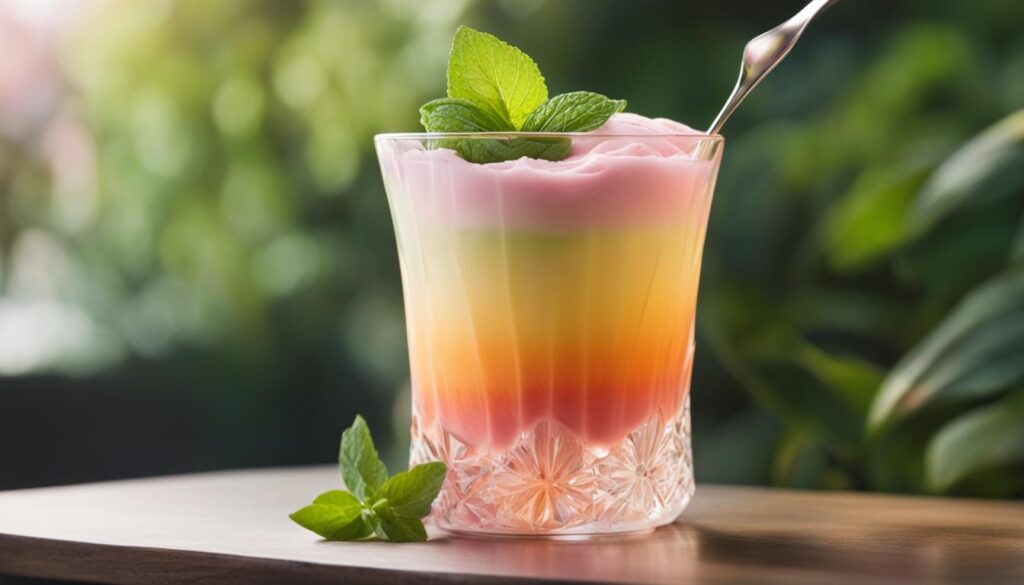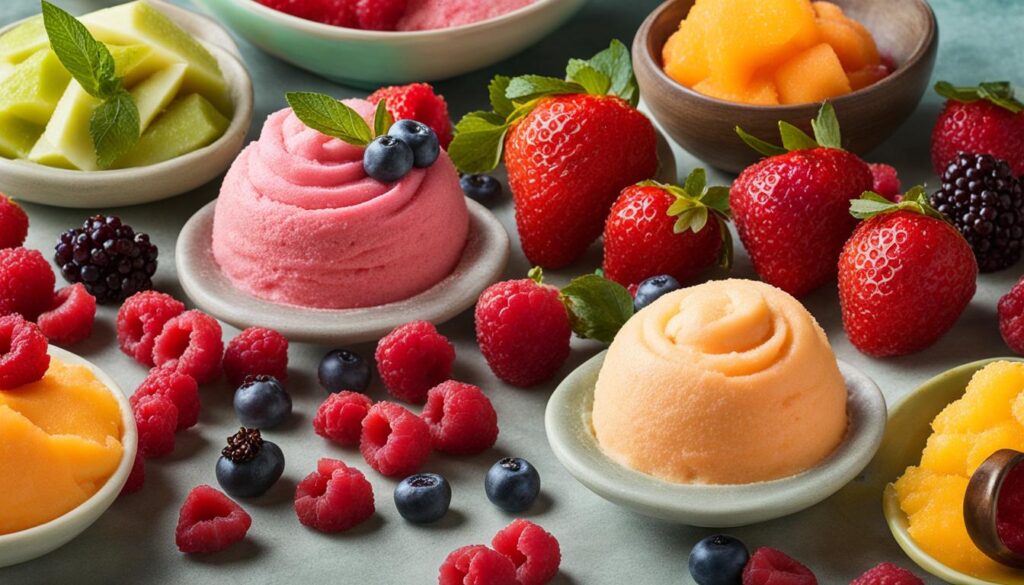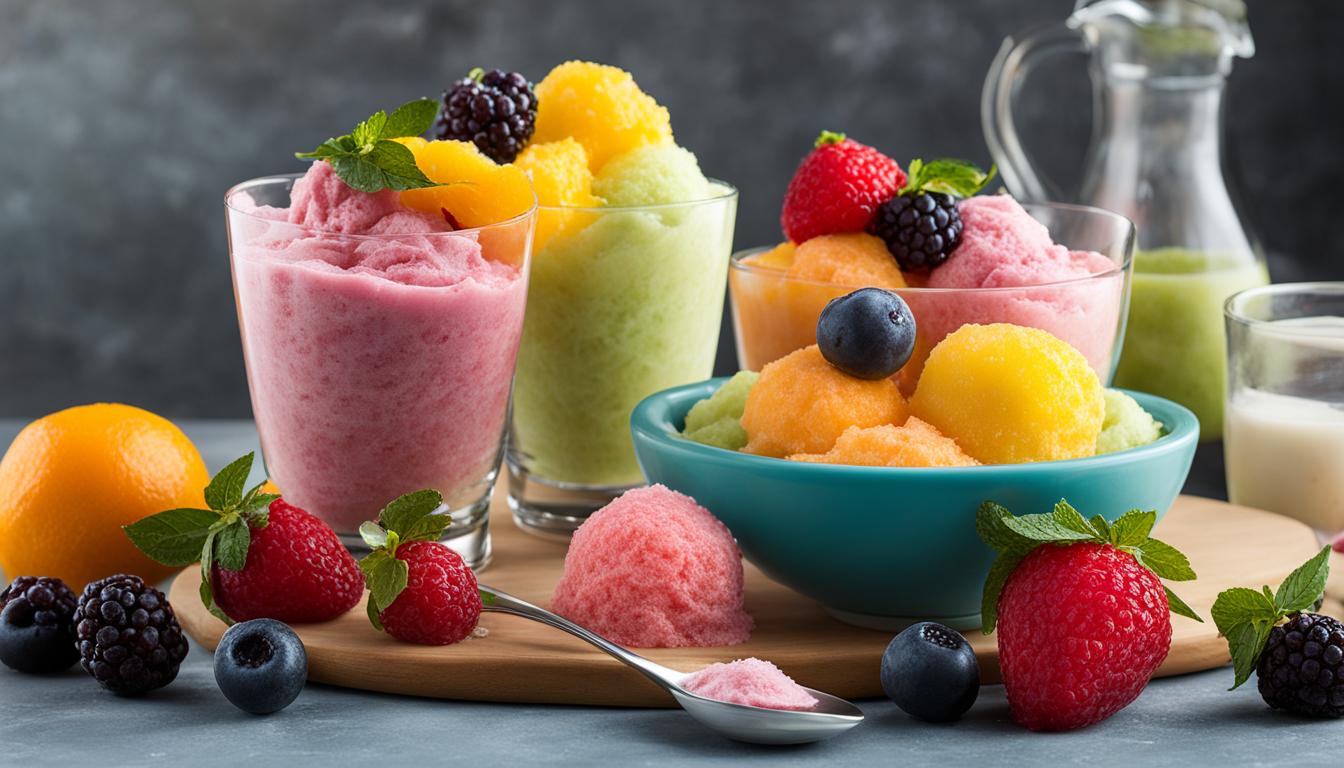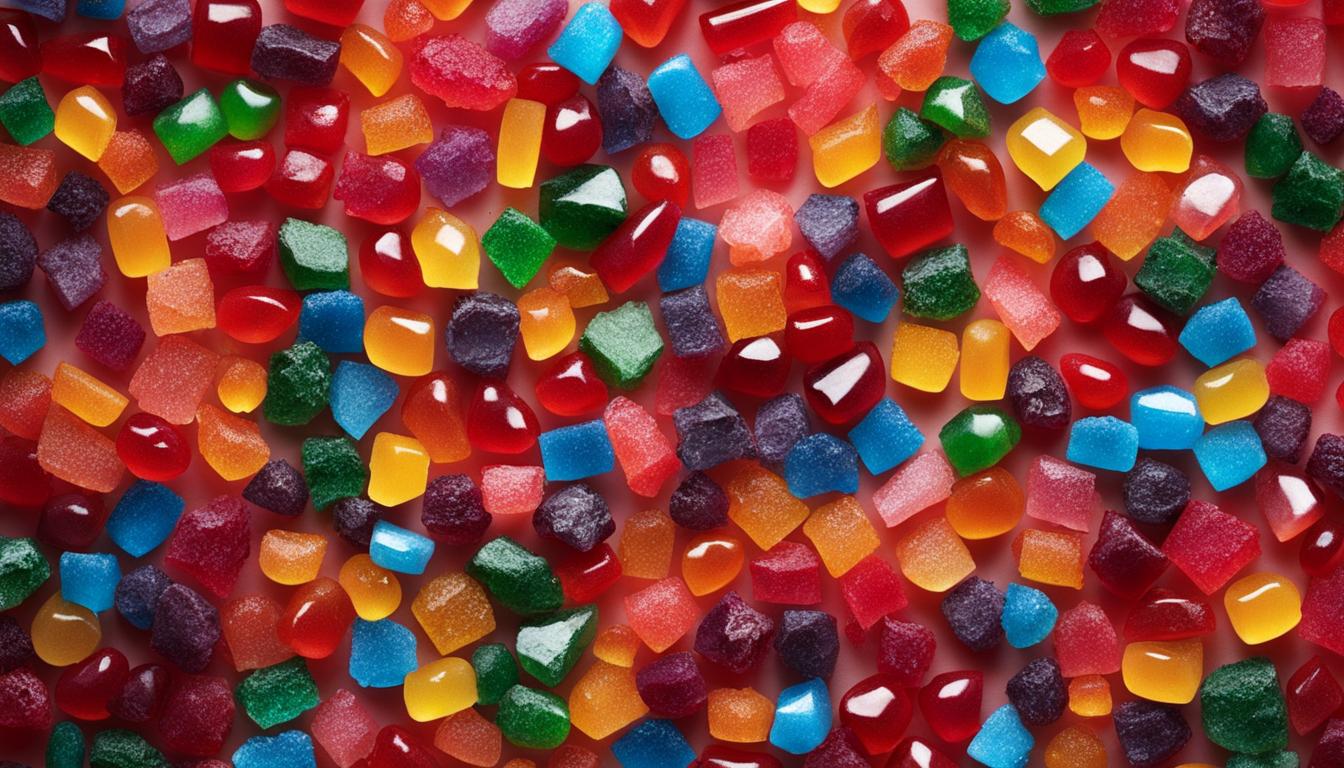Sorbet and sherbet are two popular frozen treats that are often confused with each other. While they may seem similar, there are distinct differences in their ingredients and textures. Understanding these differences can help you make the right choice when deciding between sorbet and sherbet.
Key Takeaways:
- Sorbet and sherbet are two distinct frozen treats with different ingredients and textures.
- Sorbet is made with a simple sugar syrup infused with fruit puree or juice, creating a smooth and icy texture.
- Sherbet contains a small amount of dairy, such as milk or cream, which gives it a richer and creamier consistency.
- Sorbet is dairy-free and typically has lower calories and fat content compared to sherbet.
- Both sorbet and sherbet offer a range of flavors and can be enjoyed in various dessert options.
Understanding Sorbet
Sorbet is a dairy-free frozen dessert made with just fruit and sugar. It typically has a lower calorie count and fat content compared to sherbet. The main ingredients of sorbet are fruit puree or juice and sugar, which are frozen and churned to create a smooth and refreshing texture. Sorbet flavors are primarily fruit-driven, but they can also incorporate vegetables or herbs for added complexity. Sorbet is not only enjoyed on its own, but it also pairs well with baked desserts, fresh fruit, and even sparkling wine. It can also be used as a palate cleanser between courses or as a delicious addition to cocktails.
When it comes to nutrition, sorbet is a healthier choice compared to sherbet. A ½ cup serving of sorbet typically ranges from 120 to 150 calories, with little to no fat content. Sorbet is naturally low in fat and cholesterol, making it a guilt-free treat. It is also a great option for those who are lactose intolerant or following a dairy-free diet. Additionally, sorbet is a good source of vitamins and minerals, as it is made from real fruits.
Sorbet Ingredients:
- Fruit puree or juice
- Sugar
These basic ingredients form the foundation of sorbet, but additional flavorings like herbs or vegetables can be added to create more unique and interesting flavors.
Sorbet Dessert Options:
Sorbet offers a wide range of dessert options. It can be enjoyed on its own as a refreshing and light treat, perfect for hot summer days. Sorbet can also be served alongside baked desserts like cakes and tarts to add a burst of fruity flavor. It pairs well with fresh fruit, providing a balance of sweetness and acidity. For a more indulgent treat, sorbet can be used to create sorbet floats with sparkling wine, adding a fun and fizzy twist. Additionally, sorbet can be used as a palate cleanser between courses in a multi-course meal, refreshing the taste buds and preparing them for the next dish. Overall, sorbet is a versatile and delicious dessert option that can be enjoyed in various ways.
| Sorbet | Sherbet |
|---|---|
| Lower in calories and fat | Slightly higher in calories and fat due to the added dairy |
| Dairy-free | Contains a small amount of dairy |
| Refreshing and fruity | Creamier and slightly richer in taste |
| Can be paired with baked desserts, fresh fruit, and sparkling wine | Best enjoyed on its own but can be used in certain recipes |
Exploring Sherbet
Sherbet is a frozen dessert that contains a small amount of dairy, such as milk or cream. It has a creamier consistency compared to sorbet, thanks to the added fat from the dairy. Sherbet flavors are usually fruity and have a slightly softer texture than sorbet due to the higher water content. Sherbet can be flavored with citrus fruits like lemon, orange, or lime, as well as other fruits like raspberry or pineapple. It can be enjoyed on its own or used to create fluffy molded desserts. Sherbet is a lighter alternative to ice cream and offers a creamy and refreshing taste.
The Characteristics of Sherbet
- Sherbet contains a small amount of dairy, giving it a creamier consistency.
- Sherbet flavors are usually fruity and have a slightly softer texture compared to sorbet.
- Sherbet can be made with citrus fruits like lemon, orange, or lime, as well as other fruits like raspberry or pineapple.
- Sherbet can be enjoyed on its own or used in molded desserts.
- Sherbet is a lighter alternative to ice cream and offers a creamy and refreshing taste.
Overall, sherbet provides a delightful frozen treat option with its creamier texture and fruity flavors. Whether enjoyed on its own or as part of a dessert recipe, sherbet offers a refreshing and satisfying experience.

Sorbet vs Sherbet Nutrition
When it comes to nutrition, sorbet and sherbet have some distinct differences. Sorbet is typically lower in calories and fat compared to sherbet. A ½ cup serving of sherbet averages around 130 calories and 1 to 3 grams of fat. On the other hand, sorbet ranges from 120 to 150 calories per ½ cup. Both sorbet and sherbet offer a healthier alternative to ice cream, which tends to have higher calorie and fat content.
So, why the difference? The main factor lies in the ingredients. Sorbet is made with fruit and sugar, while sherbet contains a small amount of dairy, such as milk or cream. The addition of dairy in sherbet contributes to its slightly higher calorie and fat content compared to sorbet. However, it’s worth noting that the specific nutritional values may vary depending on the brand and recipe.
To give you a clearer comparison, let’s take a look at the nutritional values of a typical ½ cup serving of sorbet and sherbet:
| Sorbet | Sherbet | |
|---|---|---|
| Calories | 120-150 | 130 |
| Fat (grams) | 0-1 | 1-3 |
Note that these values are just general ranges, and it’s important to check the nutrition label of specific brands and flavors for more accurate information.
Sorbet and Sherbet Ingredients
When it comes to the ingredients, sorbet and sherbet have some key differences. Sorbet is made with fruit puree or juice and sugar, and it does not contain any dairy products. The combination of fruit and sugar creates a sweet and refreshing treat with a smooth texture. Sorbet flavors can vary depending on the type of fruit used, and some recipes even incorporate vegetables or herbs for added complexity.
On the other hand, sherbet contains a small amount of dairy, such as milk or cream, along with fruit and sugar. The addition of dairy gives sherbet a creamier texture and a slightly richer taste compared to sorbet. Sherbet flavors are usually fruity and can range from citrus fruits like lemon or orange to other fruits like raspberry or pineapple. The inclusion of dairy in sherbet sets it apart from sorbet and offers a unique twist on frozen desserts.
To summarize, sorbet is made with fruit puree or juice and sugar, while sherbet includes fruit, sugar, and a small amount of dairy. Both sorbet and sherbet provide a wide range of flavors and can be enjoyed as refreshing and delicious frozen treats.
| Sorbet | Sherbet |
|---|---|
| Fruit puree or juice | Fruit puree or juice |
| Sugar | Sugar |
| – | Small amount of dairy (such as milk or cream) |
Sorbet vs Sherbet Taste
When it comes to taste, sorbet and sherbet offer distinct flavors and textures that cater to different preferences. Sorbet has a refreshing and fruity taste, with the intensity of the flavor coming from the fruit puree or juice. It provides a burst of natural sweetness and tanginess, making it perfect for those who enjoy vibrant and zesty flavors. Sorbet has a slightly icy texture, which adds to its refreshing nature and makes it a popular choice for hot summer days.
Sherbet, on the other hand, offers a creamier and smoother taste. The addition of dairy gives sherbet a richer flavor compared to sorbet, while still maintaining a fruity essence. The dairy enhances the taste of the fruit, creating a delightful combination of creaminess and natural sweetness. Sherbet has a slightly softer texture than sorbet, thanks to its higher water content. This makes it an excellent choice for those who prefer a more indulgent and creamy frozen treat.
Both sorbet and sherbet provide a sweet and satisfying taste, but they offer different sensory experiences. Sorbet is more refreshing and invigorating, while sherbet offers a touch of indulgence. Whether you prefer the vibrant and icy nature of sorbet or the creamy and fruity richness of sherbet, both frozen treats provide unique and enjoyable taste profiles.
Table: Sorbet vs Sherbet Taste Comparison
| Sorbet | Sherbet | |
|---|---|---|
| Taste | Refreshing, fruity | Creamy, fruity |
| Texture | Icy | Smooth |
| Flavor Intensity | Strong | Moderate |
| Preference | Refreshing, tangy | Creamy, indulgent |
The table above summarizes the taste characteristics of sorbet and sherbet. It highlights the refreshing and fruity taste of sorbet, as well as its icy texture. On the other hand, it showcases the creamy and fruity flavor of sherbet, as well as its smooth texture. Both sorbet and sherbet offer a unique taste experience, allowing you to choose based on your personal preferences.
Sorbet and Sherbet Dessert Options
Sorbet and sherbet offer a wide range of delicious dessert options that cater to different tastes and preferences. Whether you’re looking for a refreshing and fruity treat or a creamy and indulgent dessert, both sorbet and sherbet have something to offer. Here are some popular dessert ideas that incorporate sorbet and sherbet:
Sorbet Dessert Options
- Refreshing Sorbet Parfait: Layer different flavors of sorbet with fresh fruit and top with a dollop of whipped cream for a delightful and colorful dessert.
- Sorbet Float: Scoop a generous amount of sorbet into a glass and pour your favorite sparkling beverage over it, such as soda, prosecco, or champagne, for a fun and fizzy treat.
- Sorbet Tart: Create a light and tangy dessert by filling a pre-baked tart shell with your favorite sorbet flavor and garnishing with fresh berries and a dusting of powdered sugar.
Sherbet Dessert Options
- Sherbet Sundae: Scoop your favorite flavor of sherbet into a bowl and top it with whipped cream, sprinkles, and a cherry for a classic and indulgent dessert.
- Sherbet Pie: Make a refreshing and creamy sherbet pie by filling a pre-baked pie crust with sherbet, freezing until firm, and serving chilled.
- Sherbet Sandwiches: Take two cookies of your choice and sandwich a scoop of sherbet between them for a fun and tasty frozen treat.
These are just a few examples of the many dessert options you can create with sorbet and sherbet. Get creative and experiment with different flavors, toppings, and presentations to satisfy your sweet tooth. Whether it’s a light and fruity sorbet or a creamy and decadent sherbet, these frozen treats are sure to delight your taste buds.

Sorbet and Sherbet: Not Just for Dessert
Sorbet and sherbet are not limited to being served as desserts. These frozen treats can be enjoyed in various ways, adding a touch of freshness and flavor to different culinary experiences. Let’s explore some creative options beyond traditional dessert indulgence.
1. Palate Cleanser:
One unique way to incorporate sorbet and sherbet is by using them as palate cleansers between courses. These refreshing treats help cleanse the taste buds, preparing them for the next flavor journey. Serve a small scoop of sorbet or sherbet in a complementary flavor to refresh the palate and enhance the overall dining experience.
2. Starter or Mini-course:
Sorbet can also be served as a starter or as a mini-course in a dinner party menu. Its vibrant and fruity flavors make it a perfect choice to kickstart a meal. Consider serving a small portion of sorbet before the main course to awaken the taste buds and set the tone for the upcoming dishes.
3. Light and Fruity Component:
Sherbet, with its creamy texture and fruity undertones, can be used as a lighter alternative in certain recipes. Incorporate sherbet in dishes that call for a fruitier and more refreshing component. It can add a delightful twist to beverages, sauces, or even as a topping for pancakes or waffles.
By thinking beyond traditional dessert options, sorbet and sherbet can elevate the dining experience in unexpected ways. Whether it’s cleansing the palate, starting a meal with a burst of flavor, or adding a light and fruity touch to recipes, these frozen treats have endless possibilities.
Conclusion
In conclusion, sorbet and sherbet are two distinct frozen treats with their own unique characteristics. What makes a sorbet different from a sherbet is the presence of dairy. Sorbet is dairy-free, made with fruit and sugar, and has a refreshing and icy texture. On the other hand, sherbet contains a small amount of dairy, giving it a creamier consistency and a slightly richer taste.
Both sorbet and sherbet offer a range of flavors and can be enjoyed in various dessert options. Whether you prefer the refreshing and fruity taste of sorbet or the creaminess of sherbet, both frozen treats provide a delightful and satisfying experience. While sorbet is best enjoyed as a standalone dessert or paired with other fruits, sherbet is perfect for those who crave a creamier and slightly more indulgent treat.
So, the next time you’re in the mood for a frozen delight, consider the differences between sorbet and sherbet and choose the one that suits your taste preferences. Whether you opt for the refreshing simplicity of sorbet or the creamy goodness of sherbet, both will surely satisfy your sweet tooth.
FAQ
What is the difference between sorbet and sherbet?
Sorbet is a dairy-free frozen dessert made with fruit puree or juice and sugar, while sherbet contains a small amount of dairy, such as milk or cream, in addition to fruit and sugar.
What are the main ingredients in sorbet?
Sorbet is made primarily with fruit puree or juice and sugar. It does not contain any dairy products.
What are the main ingredients in sherbet?
Sherbet includes fruit, sugar, and a small amount of dairy, such as milk or cream.
How does the texture of sorbet differ from sherbet?
Sorbet has a smooth and icy texture, while sherbet has a creamier and smoother consistency due to the added dairy.
Are sorbet and sherbet healthier alternatives to ice cream?
Yes, both sorbet and sherbet typically have lower calorie and fat content compared to ice cream.
Can sorbet be used in desserts other than on its own?
Yes, sorbet can be paired with baked desserts, fresh fruit, used as a palate cleanser, or added to cocktails for a refreshing twist.
How can sherbet be enjoyed?
Sherbet can be enjoyed on its own, in a bowl or on a cone, or used to create fluffy molded desserts. It offers a creamy and fruity taste.
Can sorbet be used as a palate cleanser?
Yes, sorbet can be used as a palate cleanser between courses to refresh the taste buds.
Can sherbet be used in recipes that call for a lighter and fruitier component?
Yes, sherbet can be used in certain recipes that require a lighter and fruitier element.
 Skip to main content
Skip to main content


